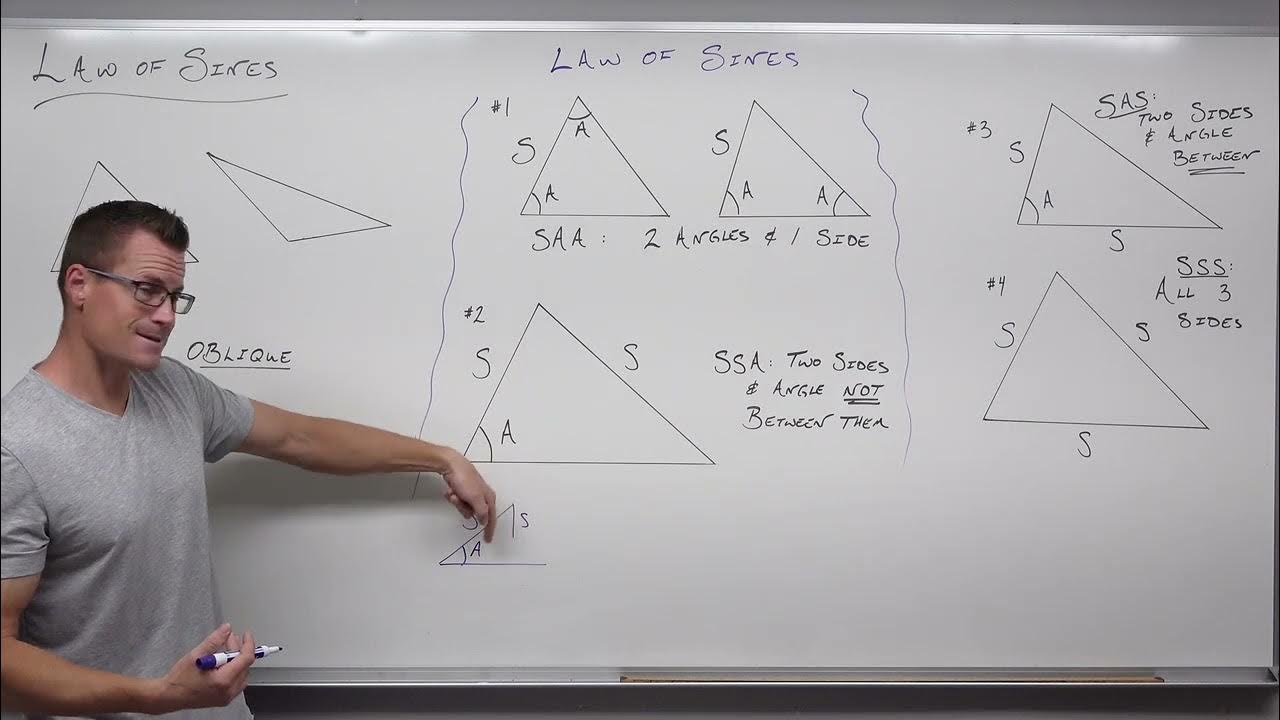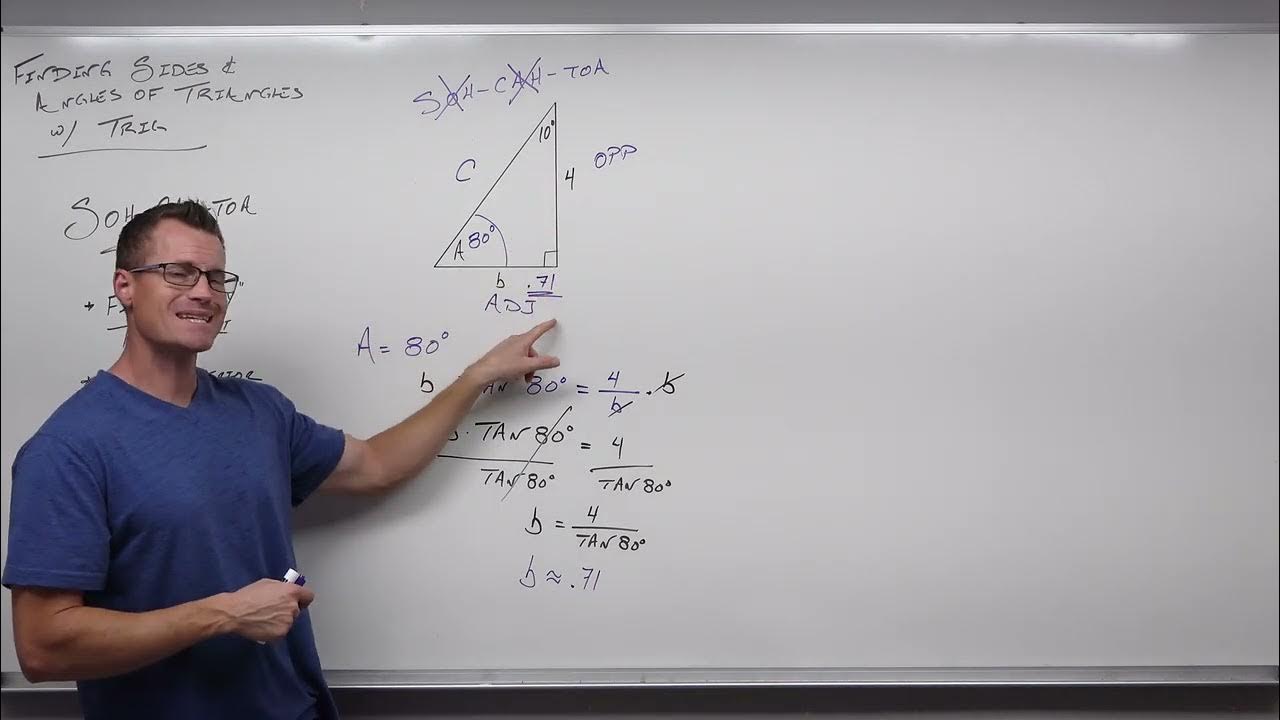Trigonometry - Real Life Applications
TLDRThe video script delves into the practical applications of trigonometry in real-world scenarios. It explains how trigonometry can be used to calculate the height of tall structures like buildings and mountains without direct measurement, by employing the tangent function and considering angles of elevation and distances from the object. The script also illustrates how trigonometry can determine distances to faraway objects, such as boats, using the angle of depression from a known height like a lighthouse. Furthermore, it demonstrates calculating the average and instantaneous speed of moving objects, like rockets, by measuring angles over time and combining trigonometry with calculus for related rates. The script also covers the use of trigonometry in physics for breaking down vectors into components, as seen in the example of a ball being kicked at an angle, and in tension force problems involving ropes. Lastly, it touches on the role of trigonometry in AC circuits, particularly in understanding phase angles between voltage, current, and resistance. The video script effectively showcases the versatile utility of trigonometry in various fields.
Takeaways
- 📐 **Trigonometry in Height Calculations**: Trigonometry can be used to find the height of tall structures like buildings by using the tangent function and knowing the distance from the structure and the angle of elevation.
- 🏞️ **Measuring Unknown Distances**: When the distance to a large object like a mountain is unknown, trigonometry can still be used to calculate its height by measuring two different angles of elevation from two different known distances and applying a specific formula.
- 🚢 **Determining Distance to an Object**: The distance to a faraway object, such as a boat at sea, can be calculated using the tangent function and the known height of an observation point like a lighthouse and the angle of depression.
- 🚀 **Calculating Speed of a Moving Object**: Trigonometry helps in calculating the average speed of a moving object, like a rocket, by measuring angles of elevation at different time intervals and using the formula that relates these measurements.
- 📉 **Instantaneous Speed with Calculus**: To find the instantaneous speed of an object, such as a rocket at a specific moment, calculus and trigonometry are combined, using the concept of related rates and the formula involving secant squared of the angle and the rate of change of the angle with time.
- 📈 **Vector Components in Physics**: Trigonometry is essential in breaking down vectors into their horizontal and vertical components using sine and cosine functions, which is crucial for analyzing motion and forces in physics.
- 🧵 **Tension Forces in Ropes**: In physics problems involving tension forces in ropes, trigonometry is used to resolve forces into components and find the tension in each rope by balancing forces along the X and Y axes.
- ⚡ **AC Circuits and Phase Angles**: Trigonometry plays a role in understanding AC circuits, particularly in the context of phase angles between voltage, current, and resistance, which is vital for analyzing the behavior of AC circuits.
- 🔢 **SOHCAHTOA for Easy Calculations**: The mnemonic SOHCAHTOA is a helpful tool for remembering the relationships between the sides of a right triangle and the trigonometric functions sine, cosine, and tangent.
- 🔄 **Concept of Angle of Depression**: The angle of depression is used to describe the angle of view from a higher point to a lower point and is congruent to the angle of elevation, which is useful in calculating distances and heights.
- 🔗 **Combining Trigonometry with Other Concepts**: Throughout the script, it's shown that trigonometry is often combined with other mathematical concepts, such as calculus for related rates, to solve more complex real-world problems.
Q & A
How can trigonometry help in finding the height of a tall building?
-Trigonometry can be used to find the height of a tall building by measuring the distance from the building and the angle of elevation from the ground to the top of the building. Using the tangent function and the SOHCAHTOA rules, the height of the building can be calculated without physically measuring it with a tape measure.
What is the formula for calculating the height of a mountain when you don't know the distance to the mountain?
-The formula for calculating the height of a mountain when the distance is unknown involves measuring two angles of elevation from different known distances from the mountain. The height (H) can be found using the formula: H = (D * tan(Θ1) * tan(Θ2)) / (tan(Θ2) - tan(Θ1)), where D is the distance between the two angles, and Θ1 and Θ2 are the first and second angles measured.
How can you calculate the distance to a boat out at sea using trigonometry?
-To calculate the distance to a boat at sea, you can use the angle of depression from a known height (like a lighthouse) and the tangent function. The distance (d) can be found by the formula: d = (height of the lighthouse) / tan(angle of depression).
What is the average speed of a rocket during a specific time interval, and how can you calculate it using trigonometry?
-The average speed of a rocket during a specific time interval can be calculated by finding the vertical distance traveled between two angles measured at different times and dividing it by the time interval. The formula to calculate the average speed is: average speed = (D * (tan(Θ2) - tan(Θ1))) / time, where D is the horizontal distance from the observer to the rocket, Θ1 and Θ2 are the initial and final angles of elevation, and time is the duration between the two angle measurements.
How can you find the instantaneous speed of a moving object using trigonometry and calculus?
-The instantaneous speed of a moving object can be found by differentiating the tangent function, which relates the angle, the height, and the horizontal distance, with respect to time. The formula for the instantaneous vertical speed (vy) is: vy = D * (dΘ/dt) / cos²(Θ), where D is the horizontal distance, dΘ/dt is the rate of change of the angle with respect to time, and Θ is the angle measured in radians.
How can trigonometry be used to find the components of a vector?
-Trigonometry can be used to find the components of a vector by breaking it down into its horizontal (x) and vertical (y) components using the sine and cosine functions. For a vector with a known magnitude (V) and an angle (Θ) with the horizontal, the horizontal component (Vx) is V * cos(Θ) and the vertical component (Vy) is V * sin(Θ).
What is a common physics problem where trigonometry is used to calculate tension forces in ropes?
-A common physics problem involves a box being pulled by two ropes at different angles. Trigonometry is used to calculate the tension forces (T1 and T2) in the ropes by resolving the forces into their horizontal (x) and vertical (y) components and balancing them out according to the conditions of equilibrium.
How are phase angles relevant in AC circuits?
-Phase angles are relevant in AC circuits as they describe the phase difference between the voltage, current, and resistance in the circuit. Trigonometry can be used to analyze and calculate the relationships between these quantities when the circuit is not in phase.
What is the SOHCAHTOA rule, and how is it used in the context of the video?
-The SOHCAHTOA rule is a mnemonic used to remember the trigonometric functions for right-angled triangles: Sine is Opposite over Hypotenuse, Cosine is Adjacent over Hypotenuse, and Tangent is Opposite over Adjacent. In the video, it is used to calculate the height of a building by relating the angle of elevation, the distance from the building, and the height of the building using the tangent function.
How does the video demonstrate the calculation of the height of a large object when the distance to the object is unknown?
-The video demonstrates this by showing a method where two angles of elevation are measured from two different known distances from the object. By creating two right-angled triangles and using the tangent function for both, the video shows how to set up equations to solve for the unknown height of the object.
What is the generic formula for calculating the height of a mountain when two angles and the distance between them are known?
-The generic formula for calculating the height of the mountain when two angles (Θ1 and Θ2) and the distance between them (D) are known is: Height = (D * tan(Θ1) * tan(Θ2)) / (tan(Θ2) - tan(Θ1)).
How can you calculate the instantaneous speed of a rocket using calculus and trigonometry?
-The instantaneous speed of a rocket can be calculated by differentiating the equation relating the tangent of the angle, the height, and the horizontal distance with respect to time. The resulting formula is: vertical speed (vy) = D * (dΘ/dt) / cos²(Θ), where D is the horizontal distance, dΘ/dt is the rate at which the angle is changing with time, and Θ is the angle in radians.
What are the two components of a vector and how can you find them using trigonometry?
-The two components of a vector are its horizontal (x) and vertical (y) components. Using trigonometry, you can find these components by considering the vector's magnitude and the angle it makes with the horizontal axis. The horizontal component (Vx) is found using V * cos(Θ) and the vertical component (Vy) is found using V * sin(Θ), where V is the vector's magnitude and Θ is the angle.
Outlines
📏 Trigonometry for Measuring Heights
This paragraph introduces the practical applications of trigonometry, particularly in measuring the heights of large structures like buildings. It explains how, using the tangent function and the concept of sohcahtoa, one can calculate the height of a tall building by knowing the distance from the building and the angle of elevation. The example provided uses an angle of 30 degrees and a distance of 800 feet to estimate the building's height at approximately 461.9 feet.
🏞️ Calculating Mountain Heights Without Distance Knowledge
The second paragraph explores how to use trigonometry to find the height of a distant object, like a mountain, when the distance to its base is unknown. It suggests measuring the angle of elevation from two different points, then calculating the height using the tangent function and the distances and angles involved. The process involves creating two triangles and solving for the height (H) using the tangent values of the two angles and the distance between the points of measurement.
📐 Trigonometry in Determining Distances
The third paragraph discusses using trigonometry to calculate the distance to a faraway object, such as a boat at sea. It describes a scenario where the height of an observer's point (like a lighthouse) and the angle of depression to the boat are known. By applying the tangent function, one can find the horizontal distance to the boat. The process is demonstrated with an example using a lighthouse height of 300 meters and an angle of depression of 30 degrees.
🚀 Trigonometry for Calculating Speed of Moving Objects
This paragraph delves into using trigonometry to calculate the speed of a moving object, such as a rocket. It outlines a method for determining the average speed of the rocket over a time interval by measuring the angle of elevation at two different times and using the tangent function to find the vertical distance traveled. The average speed is then found by dividing the total distance by the time taken.
⚡️ Instantaneous Speed Calculation with Trigonometry and Calculus
The fifth paragraph explains how to calculate the instantaneous speed of an object, such as a rocket, by combining trigonometry with calculus. It introduces the concept of related rates and shows how to derive an equation that relates the angle, the height, and the rate of change of the angle with respect to time. The instantaneous speed is then found using the secant function and the rate of change of the angle.
🚴♂️ Vector Components in Trigonometry
The sixth paragraph covers the application of trigonometry in breaking down vectors into their components. It uses the example of a ball being kicked at an angle to show how sine and cosine functions can determine the horizontal and vertical components of the ball's velocity. The process is explained using the initial speed of the ball, its launch angle, and trigonometric identities.
🔗 Tension Forces in Physics Problems
The seventh paragraph discusses using trigonometry to solve physics problems involving tension forces in ropes. It describes a scenario with a box attached to two ropes at different angles and explains how to calculate the horizontal and vertical components of the tension forces using sine and cosine. By creating a free body diagram and applying trigonometric principles, one can solve for the tension forces in the ropes.
⚡ AC Circuits and Phase Angles
The eighth paragraph briefly mentions another real-life application of trigonometry in AC circuits, specifically in the context of phase angles. It suggests that voltage, current, and resistance in AC circuits are constantly changing, making phase angles a relevant concept, although it does not provide a detailed explanation within the paragraph.
🔌 Trigonometry in AC Circuits
The ninth paragraph serves as a brief mention of the application of trigonometry in AC (alternating current) circuits without going into detail. It implies that trigonometry plays a role in understanding and working with AC circuits but does not elaborate on the specifics within this particular paragraph.
Mindmap
Keywords
💡Trigonometry
💡Height Calculation
💡Angle of Elevation
💡Tangent Function
💡Sohcahtoa
💡Distance Measurement
💡Average Speed
💡Instantaneous Speed
💡Vector Components
💡Tension Force
💡Phase Angles
Highlights
Trigonometry can be used to find the heights of tall structures like buildings without direct measurement.
The tangent function and the concept of sohcahtoa are crucial for calculating the height of buildings.
When the distance to an object is unknown, trigonometry can still be used to measure its height by taking two angle measurements from different positions.
A generic formula is provided to calculate the height of an object using two angles and the distance between them.
Trigonometry is also applicable in calculating the distance to faraway objects, such as a boat on the ocean, from a fixed point like a lighthouse.
The average speed of a moving object, like a rocket, can be determined using trigonometry by measuring angles over time.
Instantaneous speed can be calculated by combining trigonometry with calculus, specifically through related rates.
The concept of vectors and their components is introduced, and trigonometry is used to break down vectors into horizontal and vertical components.
An example of calculating the speed of a kicked ball using trigonometric functions is provided.
Trigonometry is essential for solving physics problems involving tension forces in ropes, as it allows for the calculation of force components.
A method to calculate tension forces in ropes using trigonometric functions is demonstrated with a free body diagram and force balancing.
Phase angles are mentioned as another real-life application of trigonometry, particularly in the context of AC circuits in electricity.
The video provides a correction to an earlier example, emphasizing the need for accuracy in angle measurements when calculating heights.
The importance of converting angles to radians when calculating instantaneous speed, especially when using the formula involving secant squared.
A step-by-step process for calculating the instantaneous vertical speed of a rocket is detailed, including the need for precise measurements of angle and its rate of change.
The use of trigonometry in physics to solve problems involving vectors is highlighted, with a focus on the components of force, velocity, and acceleration.
An example calculation is shown for determining the vertical and horizontal speeds of a ball kicked at an angle, using sine and cosine functions.
The video concludes with a summary of the various real-life applications of trigonometry, from physics to electricity, emphasizing its versatility and practicality.
Transcripts
Browse More Related Video

How to Use the Law of Sines in Trigonometry (Precalculus - Trigonometry 32)

Why is Trigonometry so important?

Finding Sides and Angles with Right Triangle Trigonometry (Precalculus - Trigonometry 31)

Use the Angle of Elevation to Find the Distance Between Two flying airplanes | Step-by-Step Tutorial

LEPT Math Majorship 2024 | Trigonometry Calculator Techniques

Trigonometry Basics
5.0 / 5 (0 votes)
Thanks for rating: